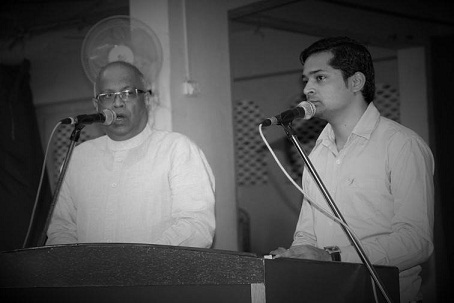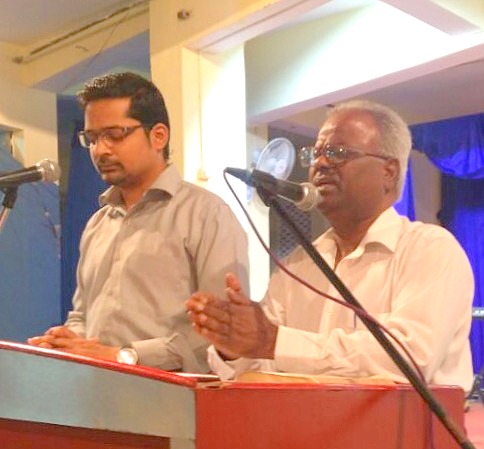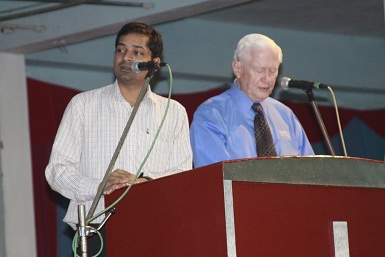I.
Introduction
·
Theological Anthropology should
be distinguished from Anthropology in general or the science of mankind. Where
the latter concern themselves with the origin and history of humankind, with
the physiological structure and the psychical characteristics of human being in
general and of the various races of mankind in particular, with their
ethnological, linguistic, cultural and religious development, and so on, the
former is concerned only with what the Bible says respecting man and the
relation in which he stands and should stand to God.
·
The transition from Theology
proper to Anthropology is a natural one because Human beings are the crown of
God’s creation and also the object of God’s special care.
·
Doctrine of humanity has always
been the implicit center of Christian faith, not only because it is human
beings who “have” Christian faith and who reflect on its meaning in theology,
but also because Christian faith focuses on the man Jesus who is the Christ.
·
It is the human beings who receive
the revelation of God, understand themselves as creatures and as sinners who
have been redeemed by God.
·
Theology deals with the nature
of humanity in relation to the question of its ultimate origin, meaning, and
destiny, that is, in relation to God, and not just its phenomenal structure as
organic and psychic being. This is why it is the revelation of God and not the
human sciences which are decisive for the doctrine of humanity.
·
It is only when God is reveled
as lord, creator and savior that we know that we are creatures, sinners, and
redeemed.
·
Doctrine of humanity has been
the subject of explicit debate down through the centuries, yet in the 19th
century with the discoveries of Darwin and Freud there is a revolution in the
understanding of humanity, which the church is still assimilating.
·
It was at the heart of the
liberal theology of the last century under the influence of Schleiermacher’s
concentration on the Christian religious consciousness.
·
The famous debate between Barth
and Brunner in the 1930s centered about the concept of the imago dei and the point of contact in humanity for revelation.
·
Bultmann with his use of
existential philosophy has once again made the doctrine of humanity central
theme of theology. For him mythological statements of the New Testament are
assertions about human existence which can best be interpreted by means of the
philosophy of Heidegger.
·
Bonhoeffer and his followers
however assert that the existentialist understanding of humanity corresponds to
a religious stage, which has now been superseded. Humanity has come of age and
is able to deal with all its problems, including anxiety and guilt, apart from
God. This has led to a renewed emphasis upon the dignity of humanity.
·
Karl Rahner the Roman Catholic
theologians developed a unique approach to the doctrine of humanity. Beginning
with an analysis of human knowledge they argue that all conscious activity
involves both self-knowledge and also an openness to all of reality, to being
as such. This means that the human knower is involved with an infinite horizon
in an awareness, which is called transcendental experience. It is this
transcendental experience, which constitutes humanity as subject, person and
spirit. This is a particular form of the fairly common modern theological idea
that humanity is constituted by its relation to God.
·
Feminist theologians have
argued that throughout Christian history the understanding of humanity has been
seen from the point of view of male experience, interests and concerns, and has
thus neglected half the human race. Human nature has been understood from the
perspective of male stereotypes of what is natural, virtuous and sinful and
therefore has been seriously distorted.
II.
Origin of Human Being
·
Every thoughtful person is
confronted with the question of his/her origin i.e. the origin of one’s being,
one’s personality etc…
·
In the modern times, the
Scriptural belief on creation narratives has not gone unchallenged.
·
The theory of evolution
propounded by Charles Darwin as a scientific theory has questioned the
authenticity of the account of creation especially of human being in the book
of Genesis.
·
The theory of Evolution
- Darwin tried to prove that human
being evolved from the lower strata of simple life through a long process
of development over million of years. For example tadpole, bat (mammals
but fly), flying fish, monkeys drop their tail to lead to the apes stage
and from apes human beings seems to have emerged from quadruped to biped
living creatures.
- Evolution just does not mean
change. It is the theory that new types arise from preceding types, the
more complex forms appearing as the descendents of the simpler ones, so
that all living things bear a relationship to one another, is called the
theory of organic evolution.
- The theory of evolution is a
complex idea. It states that all living things are related to one another
because all came from the same common ancestor far back in geological
times. It states that new species arose from preceding species of plants
and animals that were simpler, that this has been happening since plants
and animals first existed on this earth, and that it is still going on.
- The various arguments put forth by
the evolutionists are:
Ø Comparative Anatomy: This is the argument for the structural similarity between man and
the higher animals. This according to them is proof enough for evolution.
However, Gerd Theissen asks, “if man
and animals partake of the same food, same air, and have the same environment
as other creatures, should not the lungs, digestive tract, skin, eyes and so
forth, be similar?” According to him “similarity in anatomy suggests a common
creator, not one creature springing from another. Two symphonies by one
composer might be expected to have some marked similarities.” According to Louis Berkhof, “it can very well be
accounted for by the assumption that God in creating the animal world made
certain typical forms basic throughout, so as to have unity in variety, just as
a great musician builds up his mighty composition on a single theme, which is
repeated time and again, and at each repetition introduces new variations.
Ø Vestigial Organs/
Rudimentary Organs: Organs like tonsils, appendix,
and thymus gland, which, according to the evolutionist, were useful to our
supposedly more primitive ancestors, have now in human being have actually
become useless. Of late, however, the scientists are recognizing the usefulness
of the organs also.
Ø Embryology: The argument here is that the human fetus develops through various
stages which are parallel to the alleged evolutionary process, from a
one-celled organism to an adult species, but a closer study of the human embryo
has revealed that there are dissimilarities in the chronology of the
evolutionary process as propounded by the evolutionists. For example: the
earthworm which has circulation, but no heart suggests that it should be
circulation first and heart later even in human beings, but the reverse is
actually true to human beings. It is the heart first and then the circulation
Ø Bio-Chemistry and the Blood
tests: All living organisms are of a similar
bio-chemical makeup. Though originally there were some likeness but they did
not any way prove their genetic relationship. For the tests actually the
sterile drum which contains no living matter, was uses, while it is an established
fact that the solid portion of the blood, containing the red and white cells,
is the carrier of hereditary factors. Later tests, in which the spectroscope
was called into use and the entire blood was examined, conclusively proved that
there is an essential difference between the blood of animals and that of man.
Ø Paleontology: According to this argument, evidence for various kinds of life in
the form of fossils is found in the various rock strata, which actually are
ancient probably belonging to the Stone Age millions of years ago. Fossils
are remains – imprints, traces petrified or actual forms – of ancient plants or
animals preserved through the ages in rocks, tar pits, or frozen tundra. While
strata of rocks are often upturned twisted and contorted from their original
layered appearance, scientists have been able to arrange them in the order in
which they were deposited and thus to form the geologic timetable, which
reveals the order of development of evolution, of plants and animals.” The evolutionists
however fail to account for the intermediate forms, which would have been in
existence at some point of time. They were however not able to find this
missing links any more than the thousands of missing link between the various
species of animals.
Ø Genetics: This is the study of heredity and variations among related
organisms. Even here evolution has failed to authentically prove that we belong
to the lineage of beasts. Though mutation is fact but the trans-mutation is now
considered to be impossibility.
- The evolutionist says that all of
the living forms found today have been produced from one common ancestor.
Thus Darwin’s theory though is an attempt to explain the development of
life, yet it does not explain how life came into existence and how consciousness
evolved.
- Though claims of a certain amount
of change in the past can be accepted, but there is no convincing evidence
to support the theory that there has been this much change.
- Moreover, according to the laws of
thermodynamics everything that exists is some form of energy. This energy
is a constant, i.e. it does not increase or decrease in its quantity. So
no one can create anything new. It also maintains that the second law of
thermodynamics shows that no one can change to another more complex form
of life, for the change is always from the complex to the simple and from
order to disorder.
- Thus the theory of Evolution is
found replete with inconsistencies. Natural science therefore is compelled
to acknowledge an intelligent will and purpose at work in the act of
creation.
- There are however, Theistic
evolutionists teach that human being are evolved from a lower form
- Some evolutionists suggest that
the human body developed through a long evolutionary process, but God
broke into the process and directly created the soul, bringing man into
being.
- There are some others who suggest
that Adam was one among many contemporaries and that God conferred his
image on Adam’s collaterals as well as on Adam; thus Adam’s federal
headship extended to his contemporaries as well as to his offspring.
·
Scriptural account of the creation of Human
Beings
- Scripture offers us a two fold
account of the creation of human beings, the one in Gen. 1:26,27, and the
other in Gen. 2:7,21-23.
- Higher criticism is of the opinion
that the writer of Genesis pieced together two creation narratives, the
first found in Gen.1:1 – 2:3, and the second in Gen. 2:4-25; and that
these two are independent and contradictory.
- Berkhof however is of the view,
that the first narrative contains the account of the creation of all
things in the order in which it occurred, while the second groups things
in their relation to human being, without implying anything respecting the
chronological order of man’s appearance in the creative work of God, and
clearly indicates that everything preceding it served to prepare a fit
habitation for human being as the ruler of creation. It shows us how human
beings are situated in God’s creation, surrounded by the vegetable and
animal world, and how he began his history.
- Certain particular where the
creation of human being stands out in distinction from that of other
living beings:
Ø The creation of human being was in the strictest sense of the word
an immediate act of God
Ø In distinction from the lower creatures’ human being were created
after a divine type i.e. in the divine image.
Ø The two different elements of human nature are clearly
distinguished. In Gen. 2:7 a clear distinction is made between the origin of
the body and that of the soul. The body was formed out of the dust of the
ground; in the production of it God made use of pre-existing material. The soul
of man was a new production of God. The two elements are the body and the
breath or spirit of life breathed into it by God, and by the combination of the
two, human being became “a living soul,” which means in this connection simply
“a living being.” Ecl. 12:7; Mat 10:28; Luke 8:55; II Cor. 5:1-8; Phil.
1:22-24; Heb. 12:9. etc. 1 Thess. 5:23 however, recognize soul as another
constituent part of human being. The belief in this third constituent part of
human being is to express the belief that death is not the end. It is not
non-existence but we continue to live though without the physical body.
III.
The Image of God
·
The imago Dei, image of God in
human being, is first mentioned in Scripture in connection of their creation on
the sixth and final day of creation. “So God created man in His own image; in
the image of God He created him; male and female He created them. Then God
blessed them...” (Genesis 1:27,28). Some think it merely consists in dominion
over the creatures, but such an interpretation is severely restrictive. It is
far more than that. Human being in the image of God; what does this mean in
practical terms? It cannot refer to bodily, biological form since God is a
Spirit and human being is earthly.
·
The main impact of the image is
that God endues man with some of his divine attributes, thereby separating and
making him different from the beasts.
·
God is creator, the great
planner of the universe. He brought his plan to a triumphant conclusion when he
saw everything that he had made and pronounced it good. God made man and woman
a ‘them’; ‘male and female he created them. God blessed them and said to them,
Be fruitful and increase in number’ (Genesis
1:27-28). So God has given to men and women the ability to procreate
new beings in his image, little humans with bodies and minds.
·
We have an insatiable desire to
be creative, an urge increasingly emphasized (perhaps overemphasized) in
schools, and recognized even by business management. An industrialist writes,
‘There is more stability among garage mechanics, to whom every repair job is
different, who meets the customer, who sees the job through, who has the
satisfaction of putting the car on the road again, than there is in the motor
production line where the whole job has been deskilled and where the machine,
in the form of the line, dominates the man who does nothing but turn a nut with
a spanner every hour of every day of every week of every year’.
·
Animals are not creative. They
endlessly reproduce a stereotyped design. A particular spider constructs a web
of constant pattern. The song of a bird is species specific, or mimicry of
another bird or human. No originality is demonstrated.
·
Man alone can reason and act
upon his original thoughts. John Steinbeck puts it this way: ‘The last clear
function of man-muscles aching to work, minds aching to create beyond the
single need—that is man. To build a wall, to build a house, a dam, and in the
wall and house and dam to put something of Manself, and to Manself take back
something of the wall, the house, the dam: to take hard muscles from the
lifting, to take the clear lines and form from the conceiving. For man, unlike
anything organic or inorganic in the universe, grows beyond his work, walks up
the stairs of his concepts, emerges ahead of his accomplishments … . And this
you can know—fear the time when Manself will not suffer and die for a concept,
for this one quality is the foundation of Manself, and this one quality is man,
distinctive in the universe.’ Scientists would agree. They
consider the ability to use tools and tame fire the hallmark of Homo sapiens.
·
Adam was created only a little
lower than God (Psalm 8:5),
as a free spiritual being. A responsible moral agent with a thinking mind and
powers of choice and action, able to commune with God and respond to him, he
could love and worship God—or if not, as he chose. Man could rebel against God.
And the tragedy for the human race is that Adam and his wife, tempted by the
serpent, did just that. Man, with such a golden start, used his freedom to turn
against his Creator.
·
Man now misinterprets freedom
as independence. Satan’s lie was to trick man into believing that to be
independent of God was to be ‘free’. But there is no such thing as freedom. We
are all slaves, either to Christ or to Satan.
·
Since the Fall, man remains a
free agent in the sense that his decisions and conduct proceed from his inner
character and not from external constraint. But because his very nature is now
sinful, his decisions and acts are sinful too. When we do a wrong it is because
we have been tempted by our evil desire, ‘and desire, when it is conceived
gives is birth to sin’ (James 1:14-15).
Our best good is defective in the sight of God. Even our righteous deeds are as
filthy rags (Isaiah 64:6),
for a corrupt tree cannot bring forth good fruit (Matthew 7:18).
No wonder that Paul cried out, ‘I know that nothing good lives in me, that is
in my sinful nature. For I have a desire to do what is good, but I cannot carry
it out … .What a wretched man I am. Who will rescue me from this body of
death?’(Romans
7:18-19; 24)
·
Man desperately desires
freedom. But often he seeks it in the wrong place. The proliferation of new
nations in Africa followed the desire to be free from the yoke of colonialism.
But one tyranny has often been exchanged for another. University students in
the seventies thought freedom came from chanting four-letter words through a
megaphone. In the eighties they seek transient freedom through alcohol and
drugs. Civil liberty campaigners demand freedom from censorship, easier
divorce, woman’s rights, gay liberation and the like.
·
Only Christ can set men and
women free: ‘It is for freedom that Christ has set us free’ (Galatians 5:1)
(John 8:16).
In this verse the combination of the noun and verb stresses the completeness of
what has been done—free once and for all time. Vine comments, ‘The phraseology
is that of a manumission (freeing) from slavery, which among the Greeks was
effected by a legal fiction, according to which the manumitted slave was
purchased by a god. As the slave could not provide the money, the master paid
it into the temple Treasury in the presence of the slave, a document being
drawn up containing the words ‘for freedom’. No one could enslave him again. He
was the property of the god’. So Paul was able to call him ‘the
Lord’s freeman’ (1 Corinthians
7:22; 9:1).
Recently I saw a poignant car sticker, ‘Why does freedom cost so much?’ The
cost was nothing less than the death of the Son of God. No wonder Peter says,
‘You, my brothers were called to be free, but do not use your freedom to
indulge your sinful nature’ (1 Peter 2:16).
·
Modern man has got it all
wrong. Freedom is liberty, not libertinism. We are called ‘into the glorious
liberty of the children of God’ (Romans 8:2).
Adam was created free but became enslaved to sin. All men and women since have been
in bondage. Christ came to set men free, ‘Whose service is perfect freedom’. The yearning for freedom is part of the image. It remains
unsatisfied unless the slave is redeemed by Christ.
·
Therefore, the image of God in
man is basically moral and spiritual: this is indicated in Colossians 3:10,
"And have put on the new man, which is renewed in knowledge after the
image of him that created him." In conjunction we may add Ephesians 4:24,
"And that ye put on the new man, which after God is created in righteousness
and true holiness."
·
As originally created, man was
endowed with knowledge, righteousness and holiness. By his sin man was deprived
of these virtues, but through Christ he is renewed and restored to his pristine
glory, nay more than that.
·
To confirm this definition of
the image, I point out that Adam, after the fall, is said to have had children
after his image, meaning, that he had sinful offspring, just as he was sinful.
So the image of God in man is essentially man being a reflection of God in his
spiritually pure character.
·
The Fall diminished God’s
image, not only in Adam and Eve, but in all their descendants, the whole human
race. We retain the image structurally, in the sense that we remain human
beings, but not functionally, for we are now slaved to sin, unable to use our
powers to mirror God’s holiness. Regeneration begins the process of restoring
God’s moral image in our lives. But not until we are fully sanctified and
glorified shall we reflect God perfectly in thought and action as we were made
to do and as the incarnate Son of God in His humanity actually did (John 4:34;
5:30; 6:38; 8:29,46)
Image Source: https://manna.amazingfacts.org/amazingfacts/website/medialibrary/images/mediascreenshots/creation-of-man.jpg















